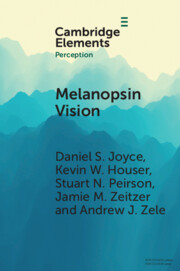Element contents
Melanopsin Vision
Published online by Cambridge University Press: 15 December 2022
Summary
- Type
- Element
- Information
- Series: Elements in PerceptionOnline ISBN: 9781009029865Publisher: Cambridge University PressPrint publication: 19 January 2023
References
- 9
- Cited by



